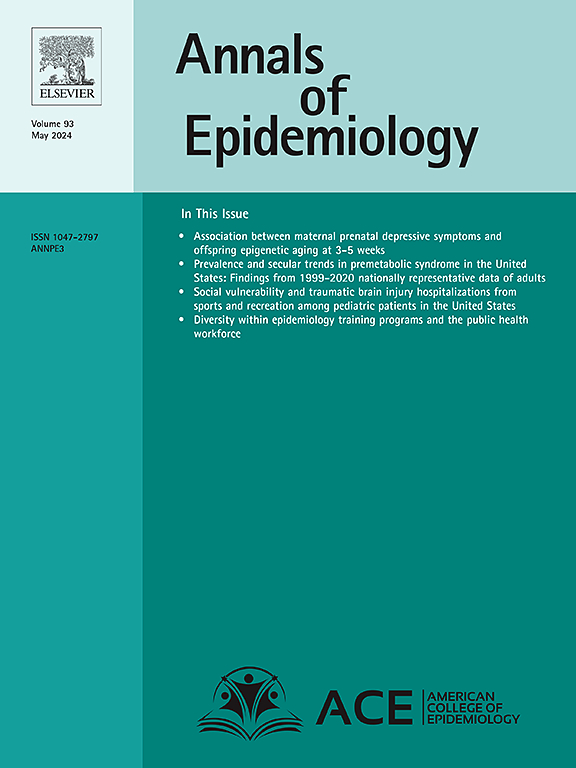Trends in cardiometabolic risk factors according to body mass index in Peru between 2015 and 2023
IF 3.3
3区 医学
Q1 PUBLIC, ENVIRONMENTAL & OCCUPATIONAL HEALTH
引用次数: 0
Abstract
Background
Global evidence has shown rising trends in the prevalence of cardiometabolic risk factors. Whether the same trends are observed according to body mass index (BMI) cut-offs is unknown, though critical to focus on specific BMI populations.
Methods
We conducted a pooled analysis of national health surveys in Peru, grouped into three-year periods (2015–17 [n = 97,079], 2018–20 [n = 98,540], 2021–23 [n = 94,850]). BMI (kg/m²) was classified into four categories: normal weight (18–24.9), overweight (25–29.9), obesity I (30–34.9), and obesity II (≥35). For each period-BMI category, we computed the age-sex-standardized prevalence of cardiometabolic risk factors: raised blood pressure with and without self-reported antihypertensive treatment, self-reported diabetes with and without treatment, daily smoking, alcohol consumption in the last month, and fruits/vegetables consumption in the last week.
Results
The proportion of people with raised blood pressure increased in the overweight and obesity groups, with the largest increase observed in the obesity II group (22 % relative increase). Diabetes prevalence rose substantially among normal weight (89 %) and overweight individuals (58 %). Smoking, alcohol, and fruit/vegetable consumption showed no major changes across BMI categories.
Conclusions
The prevalence of raised blood pressure has increased between 2015 and 17 and 2020–23, with greater increases observed in the overweight and obesity groups; conversely, the prevalence of self-reported diabetes has increased across BMI categories. These findings highlight the need for tailored interventions targeting both overweight/obese individuals and normal weight populations with diabetes risk.
2015年至2023年秘鲁根据身体质量指数的心脏代谢危险因素趋势
背景:全球证据表明,心脏代谢危险因素的患病率呈上升趋势。是否根据身体质量指数(BMI)的临界值观察到同样的趋势是未知的,尽管关注特定的BMI人群至关重要。方法对秘鲁全国健康调查进行汇总分析,分为三年期(2015-17年[n = 97,079],2018-20年[n = 98,540],2021-23年[n = 94,850])。BMI (kg/m²)分为正常体重(18-24.9)、超重(25-29.9)、肥胖I型(30-34.9)、肥胖II型(≥35)4类。对于每个时期- bmi类别,我们计算了年龄-性别标准化的心脏代谢危险因素的患病率:血压升高,有无自我报告的抗高血压治疗,自我报告的糖尿病,有无治疗,每日吸烟,上个月饮酒,上周水果/蔬菜消费。结果超重和肥胖组血压升高的比例增加,其中肥胖II组的增幅最大(相对增幅为22% %)。糖尿病患病率在正常体重人群(89% %)和超重人群(58% %)中显著上升。吸烟、饮酒和水果/蔬菜消费在BMI类别中没有明显变化。结论:2015 - 17年和2020-23年期间,血压升高的患病率有所增加,超重和肥胖人群的增幅更大;相反,自我报告的糖尿病患病率在BMI类别中有所增加。这些发现强调了针对超重/肥胖个体和有糖尿病风险的正常体重人群进行量身定制干预的必要性。
本文章由计算机程序翻译,如有差异,请以英文原文为准。
求助全文
约1分钟内获得全文
求助全文
来源期刊

Annals of Epidemiology
医学-公共卫生、环境卫生与职业卫生
CiteScore
7.40
自引率
1.80%
发文量
207
审稿时长
59 days
期刊介绍:
The journal emphasizes the application of epidemiologic methods to issues that affect the distribution and determinants of human illness in diverse contexts. Its primary focus is on chronic and acute conditions of diverse etiologies and of major importance to clinical medicine, public health, and health care delivery.
 求助内容:
求助内容: 应助结果提醒方式:
应助结果提醒方式:


